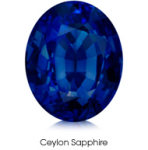Sapphire from Sri Lanka (Ceylon)
A renowned source for gemstones, the island of Ceylon (renamed Sri Lanka in 1972) holds the earliest records for the mining of Sapphires (known in Sri Lanka as "nilkata"). A classic source of quality Sapphires since antiquity, King Solomon reportedly wooed the Queen of Sheba with Sri Lankan Sapphires. Sapphires from Sri Lanka first appeared in western jewelry among the Etruscans (600 - 275 BC) and were used by the Greeks and Romans from approximately 480 BC onward.
In Sri Lanka Sapphire mining occurs in the gem rich alluvial gravels found beneath the tea-covered slopes of Elahera and Ratnapura (which literally means "gem city"). Dating to 2,500 years ago, Ratnapura holds one of the earliest records for the mining of Sapphires.
Located approximately 62 miles southeast of Sri Lanka's capital city Colombo, Ratnapura is the main alluvial gem bed found in Sri Lanka. Here Sapphires are found embedded in layers of gravel and sand, in river beds, marshes, and fields or accumulated at the foot of hills. The alluvial deposits are commonly reached by 60 - 100 foot shafts where the gem rich gravel layer is laboriously extracted by hand.
Noted for their royal and cornflower blues, Ceylon Sapphires are synonymous with top quality and are highly coveted. At Gregg's Gem House, we correctly use the prefix "Ceylon" to denote a quality as well as an origin (not all Sri Lankan Sapphires can be called "Ceylon").
Ceylon Sapphires received a boost in their popularity in 1981 when Prince Charles gave Lady Diana an engagement ring set with a stunning 18 carat Ceylon Sapphire.
Gregg and Yema Lyell
